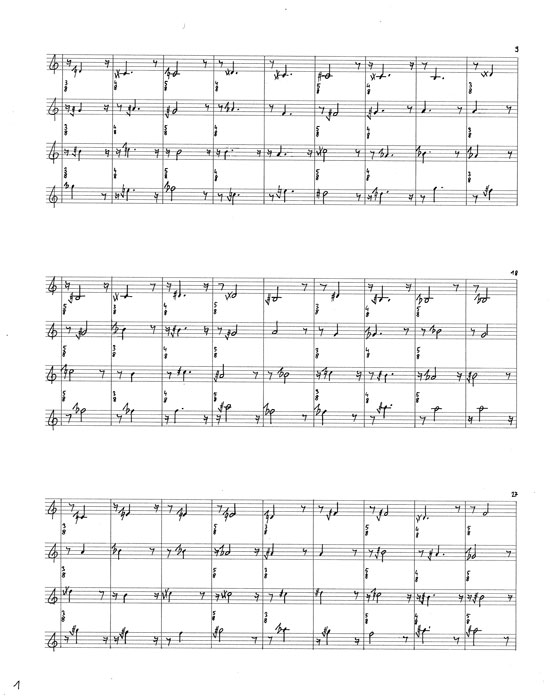Thrice again, for saxophone quartet (2015)The piece is notated in a tempered 36-tone system consisting of two third-tone scales, each derived from the two whole-tone scales of the twelve-tone system (C-D-E-F#-G#-A# and C#-D#-F-G-A-B), with soprano and tenor saxophone always playing in one scale, alto and baritone in the other. Parametric decisions are chance generated and follow a trinary code: for pitch, intonation, count time, duration and moment of attack there are three options each between which chance decides.Each part is centered on one of four reference tones, each staggered in semitone intervals; around this center, the tones meander within a range of a major sixth (30 sixth tones), forming an unpredictable microtonal chord in each measure. Every nine measures, the center shifts upward by a semitone until one part at a time reaches the upper limit of its range, which is fixed at two octaves, and re-enters at the lower end. The range of the four parts overlaps by 1.5 octaves, or it diverges by half an octave each. At the beginning of the piece, all instruments move within the intersection until the baritone saxophone is the first to reach its limit and skips two octaves lower, creating a contrast of solo to trio within the quartet. Next, the tenor sax skips, creating a two-by-two balance, and so on until all instruments have re-entered the intersection. This circulation forms the basic structure of the piece. The movement extends over a total of (36 x 9 =) 324 measures, divided into three parts, each metrically structured differently, of 108 measures each, which in themselves are divided into three sections of 32 measures each, in each of which the proportions of the sounds are distributed differently. In the third section, the element of repetition of individual bar sequences is added, whereby an effect of rhythmization sets in; however, since the time signatures change constantly, no metrical reference is established. The chance principle is disguised by the repetition, but remains latently effective, since the respective number of measures (1-3) and the frequency with which they are played (1x-3x) are also chance controlled. The motivation of the piece was to create a framework as functionally neutral as possible in order to be able to observe the relational behavior of the sounds; whereby the interval functions are neutralized by the sixth tones, the metric functions by the constant change of time signature. As a result, the immediate moments of comparison from one sound to the next come to the fore. Premiered in 2016, at Golem, Hamburg, by Konus Quartet. My sheet music is available through Frog Peak Music. 
Thrice again, für Saxophon QuartettDas Stück ist in einem temperierten 36-Ton-System notiert, das aus zwei Drittelton-Skalen besteht, die jeweils von den zwei Ganzton-Skalen des Zwölftonsystems abgeleitet sind (C-D-E-F#-G#-A# und C#-D#-F- G-A-B), wobei Sopran- und Tenorsaxophon immer in der einen Skala spielen, Alt- und Bariton in der anderen. Parametrische Entscheidungen sind zufallsgeneriert und folgen einem trinären Code: für Tonhöhe, Intonation, Zählzeit, Dauer und Anschlagsmoment gibt es jeweils drei Optionen zwischen denen der Zufall entscheidet.Jede Stimme ist auf einen von vier Bezugstönen zentriert, die jeweils in Halbtonintervallen gestaffelt sind; um dieses Zentrum herum mäandern die Töne innerhalb eines Umfangs von einer großen Sext (30 Sechsteltönen), wobei sie in jedem Takt einen unvorhersehbaren mikrotonalen Akkord bilden. Alle neun Takte verschiebt sich das Zentrum um einen Halbton nach Oben, bis eine Stimme jeweils die obere Grenze ihres auf zwei Oktaven festgeschriebenen Tonumfangs erreicht, und wieder am unteren Ende einsetzt. Der Tonumfang der vier Stimmen überschneidet sich um 1,5 Oktaven, bzw. er divergiert jeweils um eine halbe Oktave. Zu Beginn des Stücks bewegen sich alle Instrumente innerhalb des Schnittbereichs, bis das Baritonsaxophon als erstes an seine Grenze stößt und zwei Oktaven tiefer springt, wodurch ein Kontrast von Solo zu Trio innerhalb des Quartetts entsteht. Als Nächstes springt das Tenorsaxophon, wodurch ein Zwei-zu-Zwei-Gleichgewicht entsteht, und so weiter, bis alle Instrumente wieder in den Schnittbereich eingetreten sind. Diese Zirkulation bildet die Grundstruktur des Stücks. Die Bewegung erstreckt sich insgesamt über (36 x 9 =) 324 Takte, unterteilt in drei, metrisch je unterschiedlich strukturierte Abschnitte zu je 108 Takten, die ihrerseits in je drei Sektionen zu je 32 Takten unterteilt sind, bei denen jeweils die Proportionenen der Klänge anders verteilt sind. Im dritten Abschnitt kommt das Element der Wiederholung einzelner Taktfolgen hinzu, wobei ein Effekt der Rhythmisierung einsetzt; da sich jedoch die Zählzeiten ständig ändern, entsteht kein metrischen Bezug. Das Zufallsprinzip wird durch die Repetition verschleiert, bleibt jedoch latent wirksam, da die jeweilige Anzahl der Takte (1-3) und die Häufigkeit des Gespieltwerdens (1x-3x) ebenfalls zufallsgesteuert sind. Die Motivation des Stückes war es, möglichst funktionsneutrale Rahmenbedingungen zu schaffen, um das Beziehungsverhalten der Klänge beobachten zu können; wobei die Intervallfunktionen durch die Sechsteltönigkeit neutralisiert werden, die metrischen Funktionen durch den ständigen Wechsel der Taktart. Dadurch treten die unmittelbaren Vergleichsmomente von einem Klang zum nächsten in den Vordergrund. Uraufgeführt 2016, im Golem, Hamburg, vom Konus Quartett. Meine Noten sind erhältlich bei Frog Peak Music. 
|
score sample  |